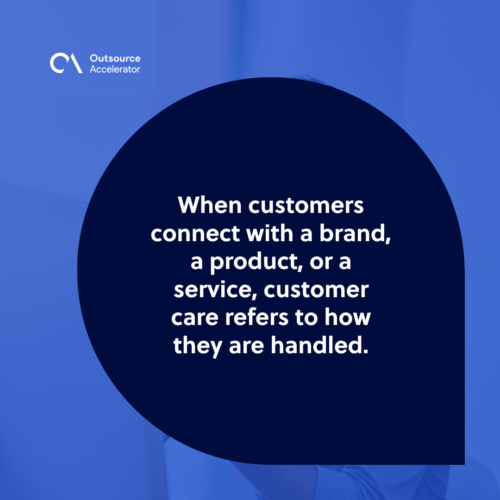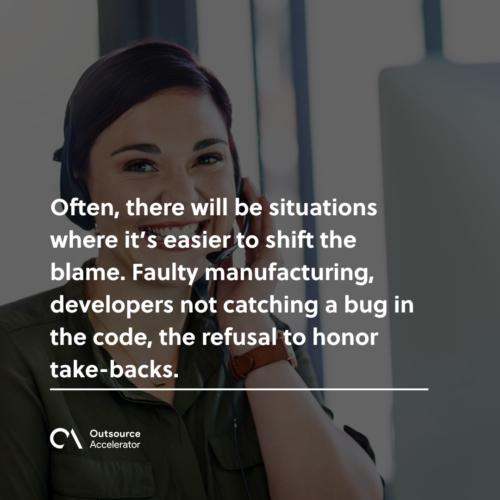Customer care: The dos and the don’ts

Undoubtedly, customer care, along with those under the ‘customer trifecta umbrella’, is of utmost importance when running a business.
The customer trifecta umbrella comprises customer care, customer support, and customer experience. When done right, these will boost morale (and sales).
These three do not solely exist for the business to take care of its target market; they are also present for the customers.
No matter what side they’re on, these three will always be present.
Keep in mind that the happier the customers, the more likely they are to turn into regular patrons.
Defining customer care
Defining customer care involves a strategic approach to handling customer interactions to ensure good customer service.
When customers connect with a brand, a product, or a service, customer care refers to how they are handled.
A key aspect of providing excellent customer service is exceeding customer expectations through personalized and efficient care.
By listening to customers, promptly addressing their needs, and going the extra mile to resolve issues, businesses achieve high customer satisfaction.
Were their concerns met with enthusiasm, curiosity, or with an unsavory attitude? Companies train customer care specialists to handle each concern and issue with ease, professionalism, and confidence.
When these customer care experts fail to do their jobs, the brand’s reputation is already damaged.

Customer care vs. Customer support vs. Customer experience
As mentioned above, customer care refers to the act of how customers are handled during the main phases of a sale.
Customer support, on the other hand, defines the process of actively supporting a customer before, during, and after they’ve interacted with your products or services.
Customer experience sums it all up, in the simplest terms. It is the summation of everything that has to do with the customer.
Further, you can look into Cloudstaff’s customer care services for inspiration.
With their client-focused agents, they provide personalized customer experiences that build meaningful relationships and brand loyalty with shoppers worldwide.
By integrating these elements strategically, businesses can foster loyalty and satisfaction among their long-term customers, ultimately leading to sustained success in the marketplace.
The customer care dos and donts
When providing great customer service, there are essential dos and don’ts every customer service team must follow.
One of the key dos is to actively listen to customer feedback and use it to improve services.
On the flip side, a major disadvantage is providing a poor customer service experience.
How a company treats customers is crucial to its reputation. Knowing the dos and don’ts of customer care ensures a positive customer experience for all.
Don’t be unprofessional
Is the customer giving you a tough time? Refrain from getting snarky and passive-aggressive with them.
Be the bigger person and maintain an air of professionalism whenever handling these kinds of calls. Remember that the customer needs YOUR help and not the other way around.
Good customer service is essential for building strong client relationships. It shows dedication to meeting clients’ needs and surpassing expectations.
Maintaining a professional demeanor in all interactions, in person, over the phone, or through digital channels, showcases the brand’s dedication to excellence and leads to increased brand loyalty.
Be courteous
When addressing a customer’s problem, it is crucial to maintain a courteous and professional attitude.
It’s important to treat customers with patience and understanding, actively listen to concerns, and work towards finding a satisfactory solution.
Save the first name salutations to a more casual setting. If your brand is more catered towards individuals rather than businesses, it may be appropriate to do so.
But until then, it’s safe for your customer care experts to use a proper salutation.
Tip: Some people may not be comfortable with the Ms., Mrs., and Mr. titles. Mx. is used by non-gender-conforming people and should be honored.
Don’t make the problem bigger than it is
Maybe the issue wasn’t something you’ve interacted with before. Maybe it’s an increasingly irate customer demanding you to call your supervisor now.
Remember your training and your product knowledge, and tackle the issue with grace. Ask for help if need be, but do so professionally.
Ask the pertinent questions to get to the root of the issue, and have the customer comply with your request so you can help them.
Do remain calm
Being just as frazzled as the customer on the other end of the call won’t help anybody.
Keep in mind that you have the tools and expertise to ease the stress that the customer is feeling. Any buyer deserves your full concentration and a kind, helpful personality.
Don’t focus on who’s to blame
Often, there will be situations where it’s easier to shift the blame. Faulty manufacturing, developers not catching a bug in the code, and the refusal to honor take-backs.
Sure, as the company’s first person in line with customers, it’s nerve-wracking to dig into an issue when it’s obvious that the customer is at fault.
The best you can do is to offer a solution to the problem. This takes us to our next point…
Do focus on the solution
In customer service, prioritizing solutions is key to improving customer retention.
When a solution is provided, you still have to walk the customer through it. Refrain from making snide comments and instead focus on the task at hand.
When faced with customer complaints, it is imperative to focus on resolving the issue swiftly and effectively.
Afterward, let the customer know that if it ever happens again, they can contact you or fix the issue themselves.
By attending to a customer immediately and providing a satisfactory solution, you show dedication to satisfaction and build trust and loyalty.
And last, this point is one of the most important takes to be said. This applies to all of us, in and out of the professional workplace.
Don’t be afraid of accountability
“Accountability is when an individual or department experiences consequences for their performance or actions,” according to Investopedia.
As mentioned earlier, the temptation to shift the blame will always be present, but it’s not a good practice.
Your job, the brand, and the products and services you offer are part of your responsibility as a customer care specialist.
Taking responsibility for any issues and defects that are rightfully yours is part of your job. It shouldn’t equate to being too soft for the job, as others may argue.
Being responsible for any mistakes that the brand makes is also a huge part of the brand’s name and reputation.








 Independent
Independent




